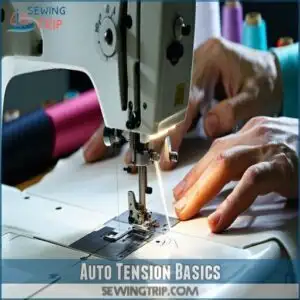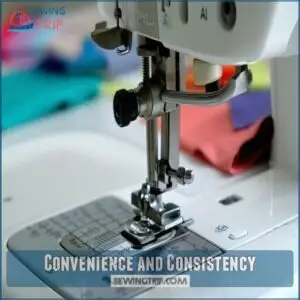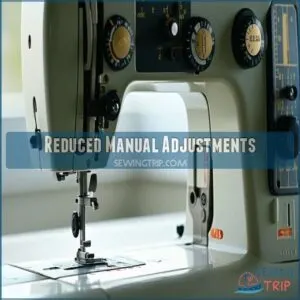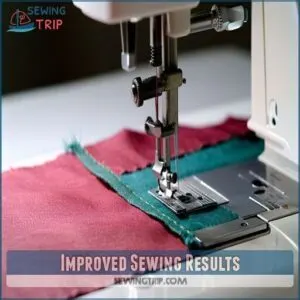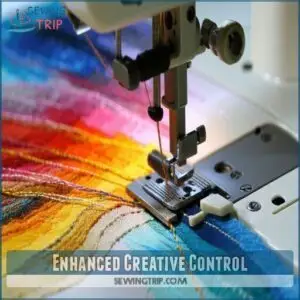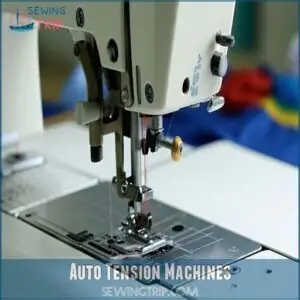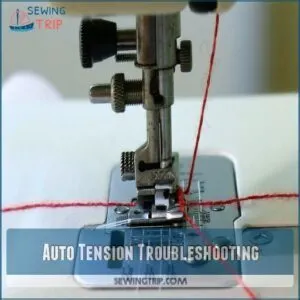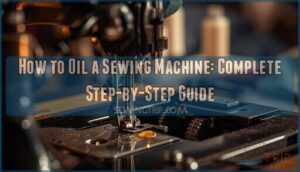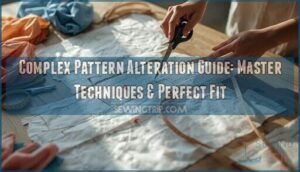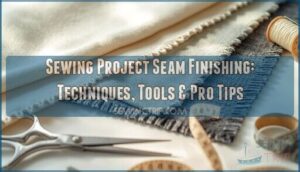This site is supported by our readers. We may earn a commission, at no cost to you, if you purchase through links.
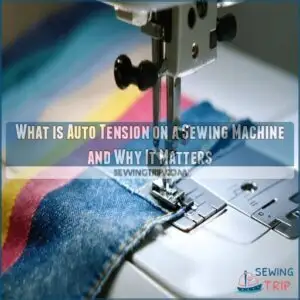
It manages the tightness of the upper and lower threads, so your stitches look even and professional, no matter the fabric or project.
This feature saves you from fiddling with knobs or guessing the right setting, whether you’re sewing delicate silk or sturdy denim, auto tension takes care of it, leaving you more time to focus on creativity.
It’s a game-changer for beginners and pros alike, of course, every machine’s auto tension works a bit differently, making it worth learning its quirks!
Table Of Contents
Key Takeaways
- Auto tension adjusts thread tightness automatically, giving you even stitches and professional stitches no matter the fabric or project.
- It saves time and eliminates the hassle of manual tension adjustments, so you can focus on your creativity.
- Balanced tension prevents common sewing issues like puckering, uneven stitching, and thread breakage.
- Auto tension works well with most fabrics and projects, but testing on scraps is key for perfect results.
Auto Tension Basics
Auto tension takes the guesswork out of adjusting thread tension, so your stitches come out neat and even every time.
It’s like having an extra pair of hands on your sewing machine, saving you time and frustration.
Thread Tension Control
Thread tension control is the heart of perfect sewing.
Thread tension control is the secret to flawless stitches, where balance turns fabric and thread into sewing perfection.
Imagine it as a tug-of-war between the thread and the fabric—just enough pull creates flawless stitches.
This balance, achieved through tension adjustment, impacts stitch quality, thread weight, and creative tension effects.
With manual vs. auto systems, you can experiment confidently, and tension troubleshooting becomes second nature, making sewing less drama and more delight!
Upper and Lower Tension
Getting sewing machine tension just right means balancing upper and lower tension. The upper tension comes from the thread path, while the lower tension relies on bobbin adjustment.
Uneven tension? Try this:
- Watch your stitch appearance—perfect tension shows seamless thread interlinking.
- Check tension balance by using different colored threads.
- Adjust tension settings slightly for different fabric weights.
It’s easier than wrangling spaghetti! Proper tension guarantees you avoid fabric puckering issues and achieve a professional finish with perfect tension and seamless results.
Tension Adjustment Techniques
Balancing sewing machine tension isn’t magic—it’s a mix of patience and practice.
To fix imbalances, try adjusting the top tension dial while considering thread weight, fabric type, and stitch length.
Creative tension techniques let you play with texture.
Auto tension simplifies it, but manual tweaks can fine-tune results.
Always test on scraps before stitching—your projects will thank you!
What is Auto Tension
Auto tension on a sewing machine takes the hassle out of adjusting thread tension manually.
Auto tension transforms sewing into a breeze, delivering flawless stitches effortlessly while you focus on creativity and enjoying the process.
By automating tension mechanics, it guarantees proper stitch formation and smooth thread delivery regardless of fabric handling.
It’s a time-saver, especially when juggling challenging fabrics or intricate designs.
Here’s why it’s handy:
- Adjusts tension automatically based on stitch needs.
- Consistently delivers balanced stitches.
- Prevents puckering and thread breakage.
- Handles fabric shifts with ease.
- Makes sewing smoother and more beginner-friendly!
It’s like having a sewing assistant in your machine!
Auto Tension Benefits
You’ll love how auto tension saves you time by keeping your stitches neat and even without constant tweaking.
It’s like having a sewing assistant who never gets tired or forgets the settings!
Convenience and Consistency
Imagine this scenario: your sewing machine glides smoothly, delivering consistent stitches every time.
That’s the magic of auto tension. It’s all about effortless sewing with reliable results.
Automatic tension brings user-friendliness to the next level, saving you time and simplifying your workflow.
Whether you’re quilting or hemming, the sewing machine’s tension system lets you focus on creativity, not adjustments.
Reduced Manual Adjustments
Using a sewing machine with auto tension saves you from constantly fiddling with tension dials.
It’s a godsend for beginners, offering consistent stitching without the trial and error.
Automatic tension boosts sewing efficiency by cutting down on time spent adjusting tension, letting you focus on creativity.
It’s a confidence builder that keeps things beginner-friendly and frustration-free!
Improved Sewing Results
Better sewing results can feel like magic with automatic tension. It handles stitch quality, thread matching, and balanced tension seamlessly, so you can focus on creating.
No more guessing or fiddling with knobs mid-project!
- Stitch quality shines with perfectly even threads.
- Fabric handling improves with fewer snags or puckering.
- Seam appearance looks clean, making every project feel professional.
Enhanced Creative Control
Art meets function with sewing machine tension artistry.
Automatic tension lets you experiment freely with stitch detailing, fabric manipulation, and thread painting.
Want dramatic free-motion effects or artistic flair?
Auto tension removes guesswork, giving you smoother sewing and freeing your creativity.
It’s a game-changer for sewing enthusiasts, turning “just stitches” into true masterpieces.
Give your creativity the reins!
Proper tension guarantees balanced, even seams, which is essential for achieving true masterpieces with your sewing projects.
Auto Tension Machines
You’ll love how auto tension machines make sewing easier and more accurate by adjusting thread tension for you.
They take the guesswork out of perfect stitches, so you can spend less time fiddling and more time creating.
Brother Automatic Tension
Ever wonder how Brother sewing machines make sewing feel effortless?
Their automatic tension guarantees perfect thread tension, saving you from annoying manual tweaks.
Models like the CP100X and Innov-is NV1800Q boast error-free calibration, offering stellar stitch quality.
Many users seek Brother auto tension parts for maintenance.
User feedback praises their reliability across fabrics, proving Brother’s auto tension technology is a game-changer for smooth, stress-free sewing adventures.
Janome Auto Tension Features
Janome models shine with user-friendly auto tension, ensuring smoother stitches and less hassle.
Its sensor technology adjusts sewing machine tension for high-quality stitch quality.
Highlights include:
- Automatic tension calibration for consistent results.
- Customizable settings for preferred sewing machine features.
- Reliable performance with diverse fabrics and threads.
- Enhanced user customization via easy manual tweaks.
Janome’s precision makes sewing feel like magic, with reliable performance that many users appreciate.
Many users find they can buy Janome parts online.
Singer Sewing Machine Auto Tension
Singer sewing machines are known for their reliability, and many models feature user-friendly auto-tension settings.
This system manages sewing machine tension with impressive accuracy, reducing guesswork. Whether you’re sewing thick denim or delicate cotton, Singer auto-tension fine-tunes thread tension for smooth stitches.
One should also be aware that improper threading causes most tension problems.
Explore different models to match preferences, and remember, periodic maintenance guarantees trouble-free settings. It’s smart sewing, simplified!
Heavy Duty Sewing Machines With Auto Tension
If you’re tackling heavy-duty tasks like denim sewing, upholstery projects, leather work, or canvas repair, a sewing machine with automatic tension is a lifesaver.
These machines handle industrial applications with steady sewing machine tension, sparing you from endless sewing machine troubleshooting.
Proper sewing machine settings keep stitches strong, even on thick fabrics, making tough jobs feel like a breeze.
For demanding projects, consider specialized tension products to guarantee superior performance.
Auto Tension Troubleshooting
If your sewing machine’s auto tension isn’t working as expected, don’t worry—it’s usually a quick fix.
With a little patience and some simple checks, you’ll be back to smooth, even stitches in no time!
Common Tension Issues
Skipped stitches or fabric puckering? Thread tension problems might be the cause!
Uneven stitches or bobbin troubles can mess up your sewing machine’s stitch quality.
Thread breakage often points to tension issues, too.
Double-check threading, clean lint, and test with simple fabrics.
A little tension troubleshooting can turn “uh-oh” moments into smooth sewing days, with simple steps to resolve the issues.
Adjusting Tension for Specialty Fabrics
Adjusting sewing machine tension for delicate fabrics or heavy materials can feel tricky, but it’s easier with the right steps.
Use test stitches on your project fabric to dial in settings for knit fabrics, metallic thread, or elastic thread.
For tension troubleshooting, clean lint, rethread everything, and test adjustments.
Sewing settings fine-tuned for fabric tension guarantee smooth, perfect stitching, which is the key to achieving perfect results with your sewing projects.
Fine-Tuning Auto Tension Systems
Fine-tuning auto tension systems feels like tweaking a recipe for perfection.
If sewing machine tension acts up, try these:
- Use manual overrides for tricky stitches.
- Perform sensor calibration for precise fabric detection.
- Check for firmware updates to optimize sewing machine automatic tension.
- To avoid puckering and bunching, make certain of proper tension balance.
- Blend hybrid systems with user preferences to find ideal tension settings.
Your perfect stitch awaits!
Maintenance and Repair of Auto Tension Machines
Keeping your machine in top shape means focusing on sensor calibration, solenoid replacement, and software updates to keep automatic tension smooth.
For sewing machine maintenance, inspect belts for wear. Physical damage can mess with sewing machine tension, so handle repairs carefully.
Regular cleaning and sewing machine tension adjustment keep performance steady. Always follow your manual—it’s your repair guide!
Frequently Asked Questions (FAQs)
What is the best tension for sewing machine?
They say practice makes perfect!
For most sewing projects, set your tension around 5—it’s the sweet spot.
But, always test first; fabrics like silk or denim might need tweaks for flawless stitches.
How do you know if your sewing machine tension is right?
Perfect tension happens when stitches look the same on both sides of the fabric.
If loops, puckers, or uneven stitches appear, it’s off.
Test with scrap fabric, adjusting until threads meet cleanly in the middle.
Is a higher number tighter tension?
Imagine threading a bow: tighter strings produce sharper snaps.
Similarly, yes, a higher number sets tighter tension on your sewing machine.
It squeezes the thread more, creating firmer stitches—ideal for strong, flat seams!
What tension should my sewing machine be on for stretch fabric?
For stretch fabrics, set your sewing machine tension slightly lower than normal, around 3-
This prevents puckering while letting the fabric move naturally.
Test on scraps first—every machine and fabric combo has its quirks!
How does auto tension react to specialty needles?
About 65% of sewists use specialty needles occasionally, but auto tension might adjust unevenly.
While it simplifies most stitching, you’ll want to test settings first since specialty needles often change thread behavior unpredictably.
Are auto tension systems suitable for industrial sewing?
Auto tension systems can work for industrial sewing, but they’re not always ideal.
Specialty fabrics and high-speed operations may require manual tweaks.
If precision matters, you’d want the flexibility of manual adjustments alongside auto tension.
How effective is auto tension with elastic fabrics?
Elastic fabrics are like unruly teenagers—stretchy and unpredictable.
Auto tension can help, but it’s not magic.
You’ll still need test runs to guarantee smooth stitches without puckering or spiraling disasters. Patience pays off!
Conclusion
Let’s face it, sewing without auto tension is like driving blindfolded—stressful and messy.
But with auto tension, your sewing machine becomes a reliable partner, adjusting thread tension seamlessly for perfect stitches every time.
Whether you’re tackling delicate fabrics or tough layers of denim, auto tension takes the guesswork out of the process, saving you time and effort.
It’s a must-have feature that simplifies sewing, boosts creativity, and answers the question, “What is auto tension on a sewing machine?”

